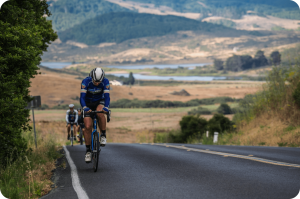Even now, there is still a debate about whether stretches for cyclists will actually help your bike performance when it comes to the amount of power you put out.
However, it certainly will help you in a couple of ways. First, it will help you get more comfortably into an aerodynamic position, whether on your triathlon bike. Secondly, it is a great idea to keep the flexibility that you have as you get older.
It also helps reduce muscle stiffness and imbalances that can lead to injury, especially in the hips, hamstrings, and lower back. These are common problem areas for cyclists. Plus, incorporating regular stretching into your routine can support faster recovery and help you stay consistent with your training.
Here, we examine some of the best stretches for cyclists, focusing on both pre- and post-ride routines.
Introduction to Cycling Stretches
Cycling is notorious for tightening up certain muscles and tensens, especially the hamstrings. So, it is essential that you regularly stretch to make sure you lessen that tightening.
A regular stretching routine can help with flexibility, reduce muscle soreness, and prevent injury so you can maintain a comfortable riding position and maximise your power output.
Static stretching and dynamic stretching are two types of stretching that can be beneficial for cyclists, static stretches help with range of motion and dynamic stretches prepare the muscles for movement.
According to this research on the effects of stretching on training cyclists, adding stretches into a cycling workout routine can help you get the full range of motion, loosen up, and improve overall cycling performance.
Cyclists can benefit from working with a yoga instructor or a coach to create a personalised stretching routine that targets the hips, thighs, and lower back.
Let’s explore some of the basic must-do stretches to perform before and after cycling workouts.
Pre-Ride Stretches
Here are five effective pre-ride stretches for cyclists, focusing on dynamic movements to warm up biking muscles and improve range of motion:
Leg Swings
Stand beside a support and swing one leg forward and backward in a controlled motion, 10-15 times per leg. This activates the hip flexors (abductor and adductor muscles) and hamstrings.
Arm Circles
Extend arms out to the sides and make small to larger circles for 10-15 seconds in each direction to warm up shoulder joints.
Walking Lunges
Step forward into a lunge, bending knees until the front thigh is parallel to the floor. Then, bring the other foot forward into the next lunge. To activate the hips and legs, do 10-15 lunges per leg.
Shoulder Circles
Extend arms and rotate shoulders forward and backward for 10-15 reps each way to loosen shoulder muscles.
Hip Rotations
Place hands on hips and rotate hips in circular motions clockwise and counterclockwise, 10-15 times each direction, to mobilize the pelvis.
These dynamic stretches prepare key cycling muscles like quads, hamstrings, glutes, and core, improving blood flow and reducing injury risk. Starting your ride slowly after these stretches also helps your muscles warm up gradually.
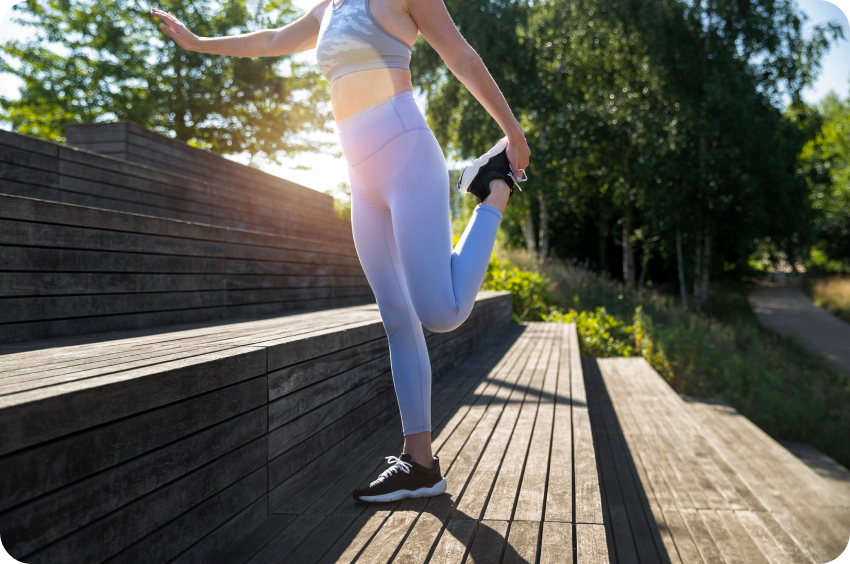
Post-Ride Stretches
Here are five essential stretches you can do post-ride to release those tight muscles.
Quad stretch
Pick up your foot by your ankle, pull up your heel towards your buttocks whilst keeping your thighs pushed forward. You should feel a real tight stretch along your quad. Just to make sure you keep your balance it is always a good idea to rest your arm against the wall or other flat surface.
Hamstring stretch
As I’ve already mentioned, cyclists have notoriously short hamstrings, and there is a reason for this. That is because, as you are pedaling, you never fully extend them as you are going around the pedal stroke. So it is really important to focus on the post-ride.
Here’s a basic static stretching for your hamstrings:
Keep your feet shoulder-width apart, trying to keep your back and trunk as straight as possible. Then, lean your body forward and reach towards the floor.
Hip flexors stretch
Hip flexor and piriformis stretches can help lengthen the muscles in the front of the hip, reducing tension and improving range of motion.
To stretch your hip flexors, you can do simple lunges post-ride.
Make sure you push your hips forward and you will feel a really good stretch across the front of your hips. Do it 6-8 times on one leg, and then repeat on the other leg.
Keep your front knee stable and behind the line of your toes.
Glutes stretch
Lie on your back, grab behind your right knee and pull gently towards your chest, hold it and release. Keep your left leg straight. Do it about 6-8 times on each side, and for the last stretch, just hold it for a few more seconds.
Medial glutes + lower back stretch
Lower back and glute stretches can help lengthen the muscles in the lower back and glutes, reducing tension and improving flexibility.
Lie on your back, put one ankle over the other knee, then pull that knee up towards your chest. You are going to feel this stretch in your glutes and also possibly down the side of your leg on your IT band. It is a great stretch for cyclists. Hold it there for 10-15 seconds and repeat it 4-5 times on each side.
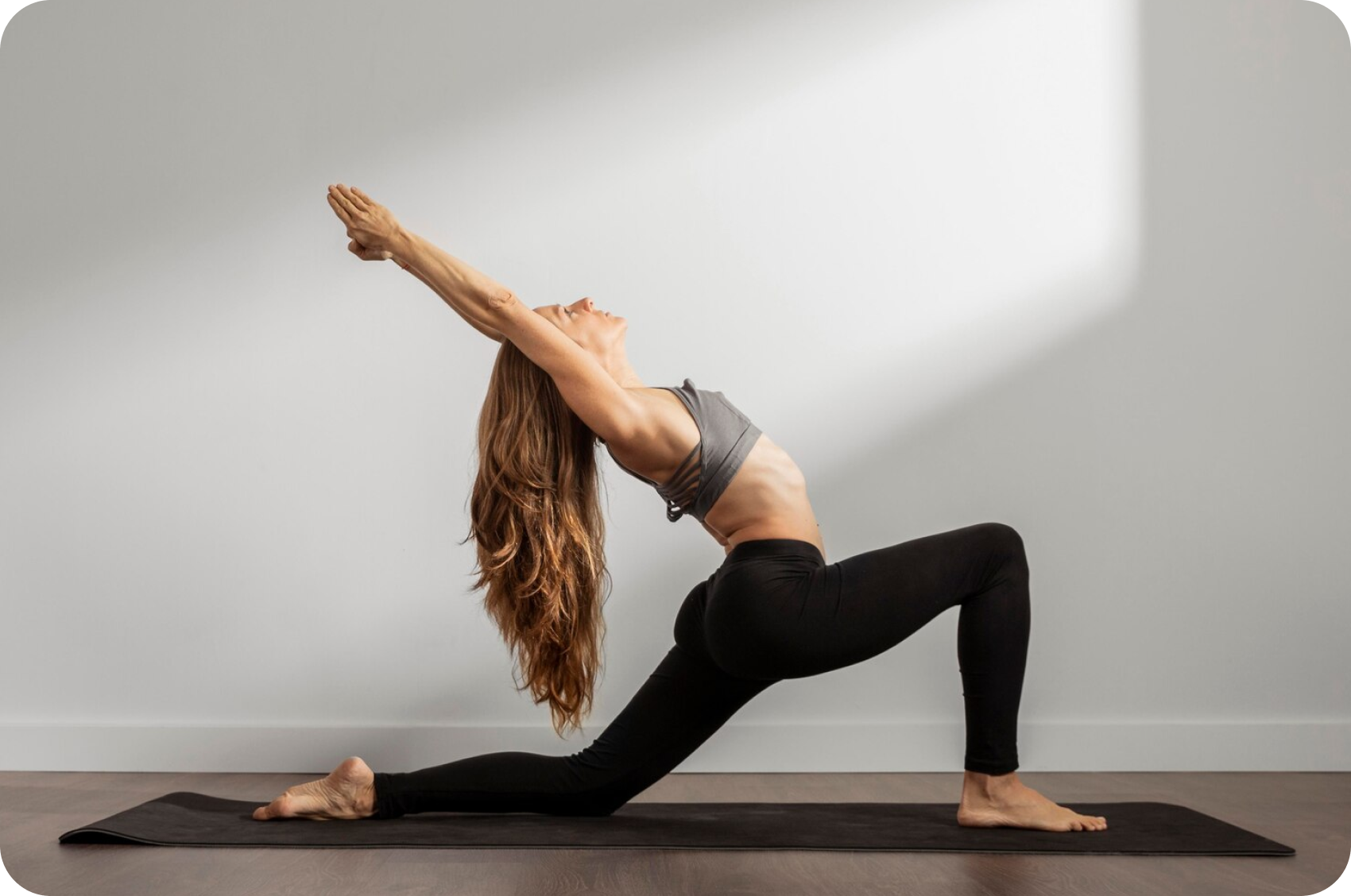
Foam Roller Techniques
If you haven’t tried a foam roller before, you are missing out. Foam rolling can reduce muscle soreness and improve short-term range of motion without negatively affecting performance.
It’s especially helpful for tight quads, hamstrings, IT bands, and calves as those areas are heavily used during cycling. Here are key techniques and areas to focus on:
1. Quads (Front Thighs)
- Lie face down with your thighs on the roller and support yourself on your forearms.
- Roll from just above the knees up toward the hips, pausing on tight spots.
2. Glutes
- Sit on the roller, cross one ankle over the opposite knee, and lean toward the glute of the crossed leg.
- Roll back and forth to target deep gluteal muscles and piriformis.
3. IT Band (Outer Thigh)
- Lie on your side with the roller under your outer thigh.
- Support yourself with your arms and roll from the hip down to just above the knee, focusing on tender areas.
4. Hamstrings
- Sit with the roller under your thighs.
- Roll from just below the glutes to above the knees, working gradually along the muscle length.
5. Calves and Shins
- Place the roller under your calves or shins and roll back and forth, using your arms for support.
- This helps relieve tension from prolonged pedal motion.
Remember to move slowly and pause on tight or sore spots for 20–45 seconds to allow the muscle to release. This might hurt a little, but you will feel relief after.
Try to spend 1–2 minutes on each muscle group.
Using a foam roller seems simple and straightforward, but there are a few things to keep in mind:
- Do not roll out too quickly, as it prevents tissue release and may increase tightness.
- Maintain good posture and engage your core to avoid injuries.
- Avoid applying too much pressure on the tight area. If you feel 7 out of 10 pain, do not press any harder.
- Do not roll the lower back area as it can trigger spasms. Instead, focus on the upper back.
- Rolling cold muscles can lead to bruising, so warm up first.
- Rolling injured areas can worsen conditions; seek professional guidance instead.
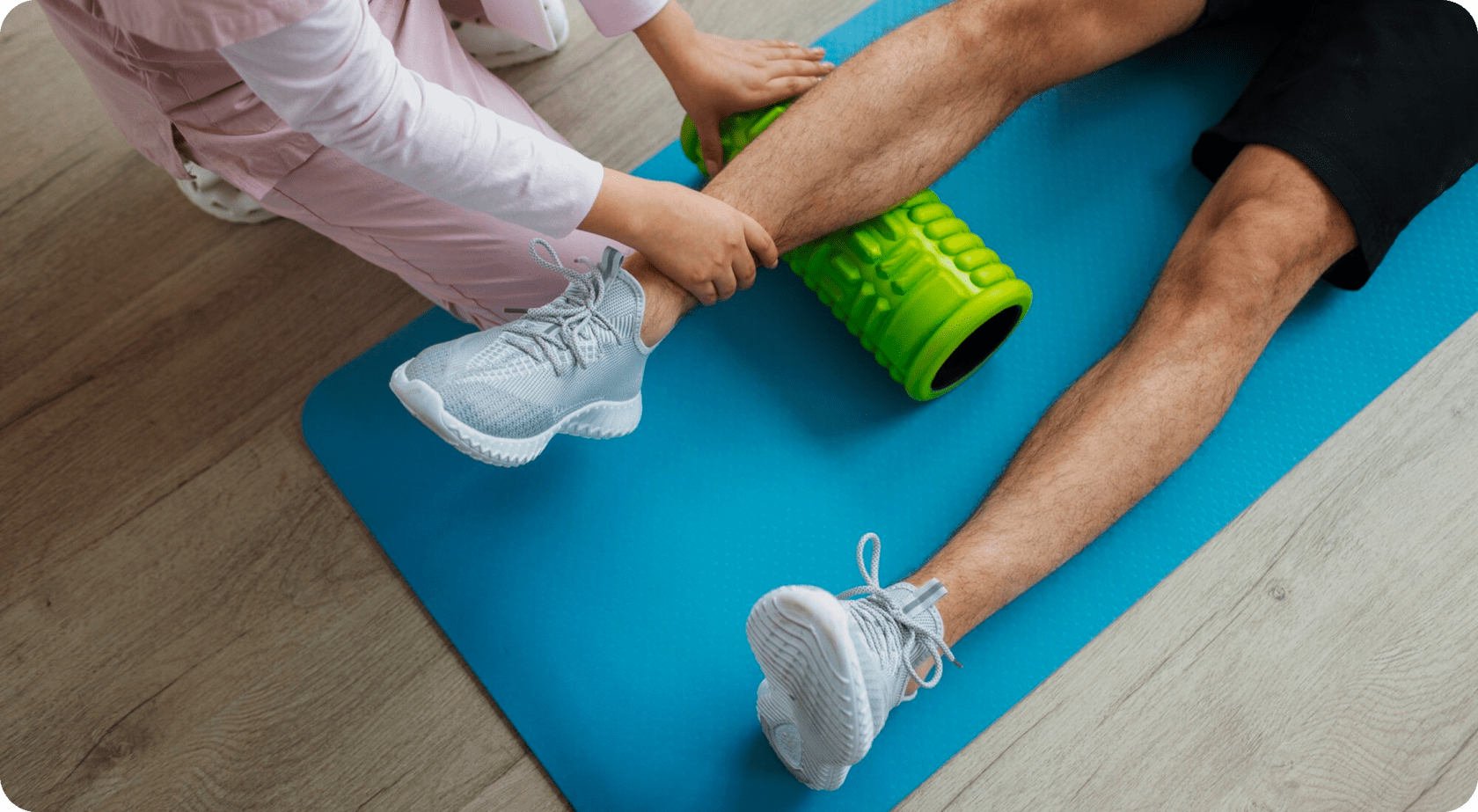
Upper Body Stretches
While cycling mainly targets the lower body, the upper body, especially the neck, shoulders, back, and wrists, can get stiff and sore due to prolonged posture on the road or triathlon bike. Stretching these areas improves posture, reduces muscle tightness, and helps prevent overuse injuries.
A review of the acute effects of static and dynamic stretching on performance found that stretching the upper body can enhance flexibility and reduce musculoskeletal discomfort in endurance athletes, including cyclists.
Here are some effective stretches based on recommendations from triathlon coaches:
Open Book with Arm Sweep
Lie on your side with knees bent and stacked. Extend arms forward with palms together.
Sweep the top arm in a semicircle behind your chest, rotating the upper body while keeping your hips stable.
Repeat 3 times per side.
This stretch improves thoracic mobility and helps with the twisting motions cyclists perform on the bike.
Chest Stretch on Exercise Ball
On all fours, place one elbow on a ball with the palm facing down. Rotate your upper body away from the ball to stretch the shoulder and chest.
Hold briefly, then relax and repeat 4-6 times per side.
This dynamic stretch awakens tight chest muscles and increases blood flow before riding.
Cobra Stretch
Lie face down with hands under shoulders. Push your upper body up, lifting your chest and pressing your shoulder blades while keeping your hips on the floor.
Hold for 5 seconds and repeat 3 times.
Doorway Chest Stretch
Stand in a doorway, place forearms on the door frame at shoulder height. Step forward gently to stretch the chest and shoulders.
Hold for 10-20 seconds and repeat on both sides. This stretch opens the chest and helps correct forward shoulder posture. Make sure you maintain a straight line for a proper effect.
Here are more tips on dealing with forearm muscle pain for athletes.
Neck Stretch
Slowly tilt your head to one side and gently assist with your hand.
Hold for 30 seconds per side. This relieves neck tension caused by prolonged cycling workouts or cycling interval training.
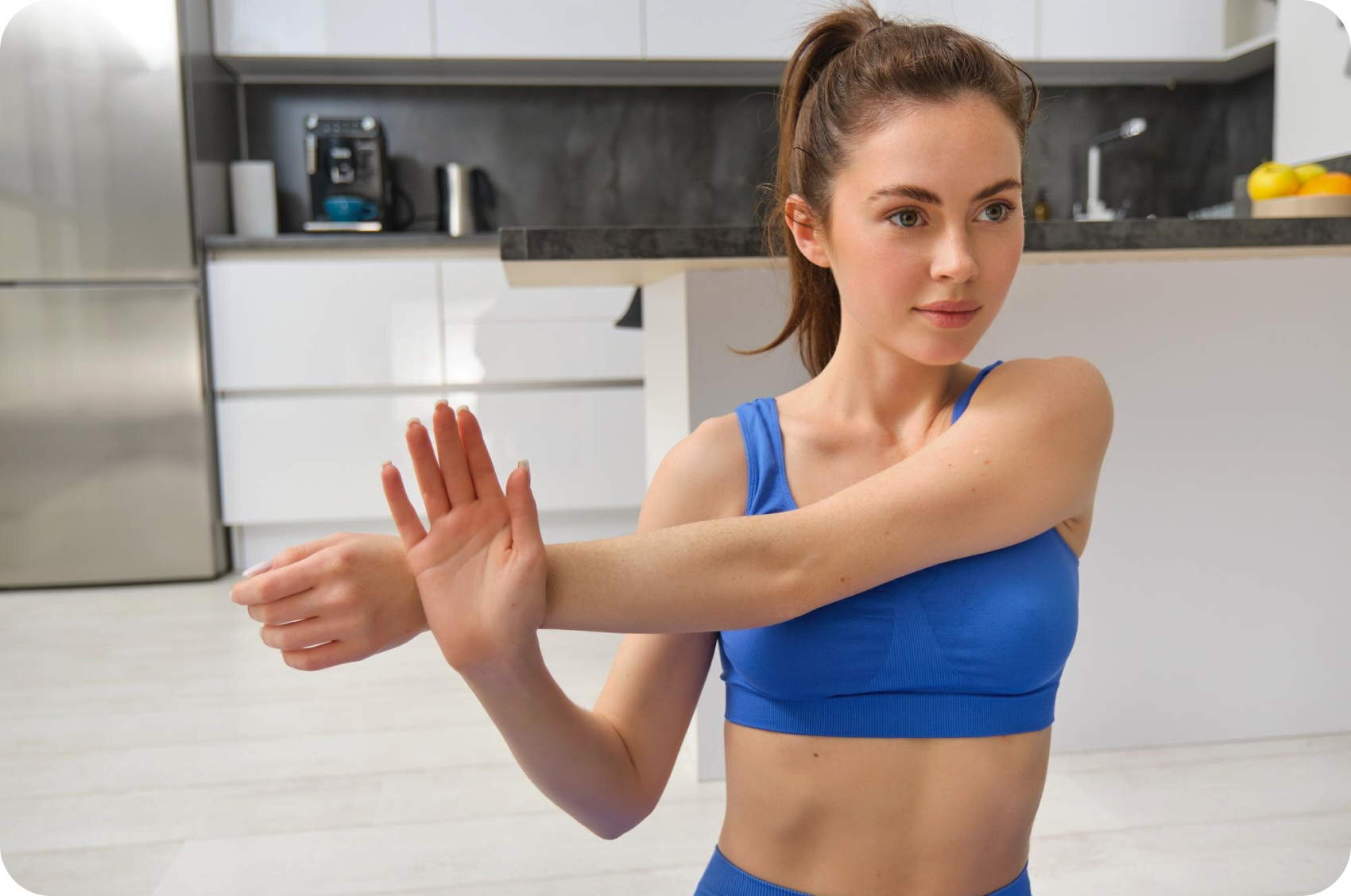
Common Stretching Mistakes
Here are some of the most common stretching mistakes cyclists and triathletes should avoid:
- Using a bouncing or ballistic motion can cause muscle strains or tears, as it forces muscles to stretch too quickly and can lead to overstretching.
- Attempting to stretch a muscle that is already injured can worsen the damage and delay recovery. Instead, follow rest and recovery protocols for injuries.
- Doing prolonged static stretches before cycling can reduce performance and increase injury risk. Opt for dynamic stretches pre-ride and save static stretches for after your workout.
- For flexibility gains, stretches should be held for at least 45–60 seconds; shorter durations may not be effective.
- Repeating only a few stretches can create muscle imbalances. Vary your routine to target different muscle groups.
- Pushing too far or too fast can lead to pain or injury. Stretch only to the point of tension, not pain.
- Irregular stretching routines limit progress. Consistency, even in short daily sessions, is more beneficial.
- Stretching cold muscles increases injury risk. Warm up lightly before stretching for better results.
Closing Thoughts
Stretching should be a key part of every cyclist’s routine, not just something you do when you’re sore.
It helps counteract cycling’s repetitive motion and fixed posture, reduces the risk of injury, prevents cramps while cycling, and improves comfort on longer rides.
A good mix of lower and upper body stretches can relieve tightness in the hips, hamstrings, back, and shoulders. Both dynamic and static stretching exercises improve flexibility and joint mobility, which can enhance your pedaling efficiency (including training stress score) and reduce fatigue.
Stretching regularly, especially after rides, increases blood circulation and reduces muscle stiffness.
And the best thing is that you don’t need to spend a long time on it. Even 10 minutes can make a difference.
